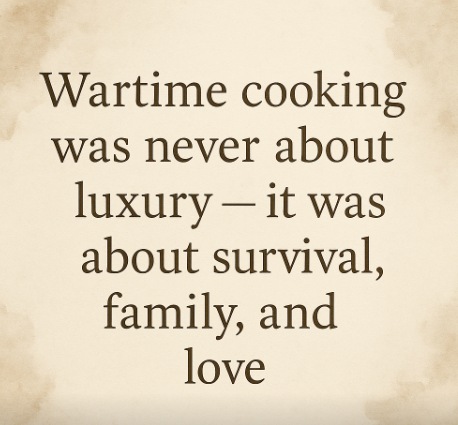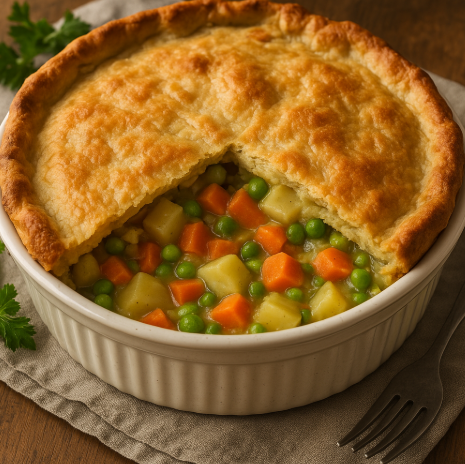Home › Forums › Muse & Mingle Club – OAM › Creative Currents › Wartime Cooking and Rationing & Recipe
- This topic has 0 replies, 1 voice, and was last updated 5 hours, 28 minutes ago by
 Abbie Shores.
Abbie Shores.
-
AuthorArticles
-
-
28/08/2025 at 12:18 #48777
 Abbie ShoresKeymaster::
Abbie ShoresKeymaster::This topic was automatically created for discussion of the article:
A look back at how British families coped with food shortages during the Second World War, the inventive recipes that emerged, and the influence of Mrs Beeton’s enduring household wisdom.
Wartime Kitchens
When Britain entered the Second World War in 1939, it was not only soldiers who faced battles. At home, the kitchen became a frontline of its own. By January 1940, strict rationing was introduced to ensure that food supplies lasted and were fairly shared. For families, this meant carefully guarding their ration books, queuing at shops, and learning to make the most of whatever was available.
The challenge was daunting. Meat, sugar, butter, and eggs were in short supply. Imported goods were scarce due to disrupted shipping. Yet, in small terraced houses and country cottages alike, mothers managed to put meals on the table, stretching rations with creativity and determination.
Not all women were in the kitchen, of course. With so many men away at war, thousands worked in the munitions factories or joined the Women’s Land Army. My own great-aunt was one of those on the farms, and thanks to her, my nana and grandpa were sometimes lucky enough to receive a little extra fresh food. For many families, those connections made all the difference in brightening an otherwise meagre table.
 Coping with Rationing
Coping with RationingEach person was allowed only limited amounts: a weekly ration might include a small portion of bacon, a few ounces of butter, some sugar, and perhaps a single egg. Families turned to home-grown produce, encouraged by the government’s “Dig for Victory” campaign. Gardens, allotments, and even parks were transformed into vegetable plots, producing carrots, cabbages, and potatoes in abundance.
Mothers became experts in making meals stretch. Leftovers were never wasted, and inventive substitutes appeared in everyday cooking. Syrup, honey, or carrots provided sweetness when sugar was scarce. Powdered milk and dried eggs became common store-cupboard staples, despite their unappealing textures.
It was not easy, yet the spirit of “make do and mend” applied just as much in the kitchen as it did with clothing and household goods. My own great-grandmother — Nana’s mother — had once been a seamstress for Queen Victoria, one of many who worked tirelessly behind the scenes. She passed her skills on to Nana, who could mend anything and often did, darning socks and patching clothing for her family as well as for neighbours in need. Like so many women of the time, she kept garments in use long after their natural lifespan, proving that resourcefulness and care were as valuable as any ration.
Creative Recipes and Substitutions
Some of the most memorable recipes from the period reflect this inventiveness. Perhaps the best known is Woolton Pie, named after Lord Woolton, the Minister of Food. It consisted of a medley of vegetables — carrots, parsnips, turnips, and potatoes — bound together with a simple white sauce and topped with pastry or mashed potato. It was nutritious, filling, and entirely meat-free.
Other recipes included mock goose (made with potatoes, sage, and apples), carrot fudge (a sugary treat without chocolate), and cakes baked with grated beetroot to provide sweetness and moisture. Dried egg powder was reconstituted with water and used in everything from pancakes to custards, though many remember it with little fondness.
These recipes might seem plain by today’s standards, but they were symbols of resourcefulness, keeping families fed during one of the hardest periods in modern history.
Guidance from Government and Mrs Beeton
The Ministry of Food played a central role in guiding households through rationing. Pamphlets were widely distributed, and radio programmes such as “The Kitchen Front” offered practical advice. Women were encouraged to try new recipes, use vegetables creatively, and avoid waste at all costs.
At the same time, many kitchens still kept a copy of Mrs Beeton’s Book of Household Management. Though Isabella Beeton had lived a century earlier, her book remained a trusted reference. Her advice on thrift, careful planning, and household order felt especially relevant in wartime, even if the rich Victorian recipes required heavy adaptation to suit rations.
Many families owed her a great deal: her chapters on economical cookery, stretching leftovers, and making nourishing meals from the simplest of ingredients offered practical guidance that could be applied even in the toughest of times. She reminded readers that skill and care were as important as the ingredients themselves, and in this, she gave confidence to countless women faced with nearly bare cupboards.
But Mrs Beeton was not the only influence. The Ministry of Food issued pamphlets and small recipe books such as Food Facts and Victory Cookery Book, while Marguerite Patten, later to become one of Britain’s best-known cookery writers, gave advice on the BBC’s Kitchen Front broadcasts. These modern sources, combined with Beeton’s enduring wisdom, meant that households had both tradition and new authority to lean on.
So what did rationing actually look like? By 1940, each person’s weekly allowance typically included:
- 4 oz (about 110g) of bacon or ham
- 2 oz (about 55g) of butter
- 2 oz (55g) of cheese
- 4 oz (110g) of margarine
- 4 oz (110g) of cooking fat
- 8 oz (225g) of sugar
- 2 oz (55g) of tea
- 1 fresh egg (plus dried eggs occasionally)
- 1 lb (450g) of meat
Extras such as sweets, jam, and biscuits were rationed separately and varied depending on supply. Fruit and vegetables were not rationed, but they were often scarce, which is why the “Dig for Victory” campaign was so crucial.
The Legacy of Wartime Cooking
Wartime cookery left a lasting impression on British food culture. The emphasis on vegetables, thrifty use of ingredients, and avoidance of waste continued long after rationing ended in 1954. Generations of children grew up on simple meals, learning to appreciate the value of food and the effort it took to bring it to the table.
Today, many of those recipes are looked back on with nostalgia, even if few would willingly return to dried eggs or mock goose. What endures is the admiration for the women (and it was most often women) who turned scarcity into sustenance. Their resilience and ingenuity remain part of the tradition of British kitchens.
Cooking during the Second World War was never about luxury — it was about survival, family, and love expressed through whatever could be placed on a plate. It stands in stark contrast to today’s throwaway and takeaway culture, reminding us that food is not only nourishment but also a reflection of care, resourcefulness, and the times we live in

Woolton Pie Woolton Pie (Original Ministry of Food Recipe, 1941)
Ingredients:
1 lb (450 g) potatoes
1 lb (450 g) cauliflower or parsnips
1 lb (450 g) carrots
1 lb (450 g) swede or turnip
2 leeks
1 small onion
1 teaspoon vegetable extract or oatmeal (to thicken)
Parsley (chopped)
A little margarine or dripping
1 pint (570 ml) vegetable stock or water
Wholemeal pastry or mashed potato for toppingMethod:
Dice all the vegetables. Place them in a saucepan with the stock or water, add the vegetable extract or oatmeal, and simmer until tender.
Season lightly with salt, pepper, and parsley.
Place the cooked vegetables and thickened liquid in a pie dish.
Cover with either a crust of wholemeal pastry or a mashed potato topping.
Bake in a moderate oven until the top is browned.Note (Ministry of Food, 1940s):
“Variety may be obtained by adding celery, mushrooms, or peas, and flavourings of herbs, nutmeg, or grated cheese (if available).”✍️ Submit a Guest Post
Not a member yet? You can still share your creative voice with our readers. We welcome guest posts from artists, writers, and creative souls of all kinds.
Share this link with your friends if you enjoyed the post 🙂 See the share buttons below to your right
Read the full article: https://ourartsmagazine.com/blog/wartime-cooking-and-rationing-recipe/
—
Source: Our Arts Magazine---------
Site Owner
-
-
AuthorArticles
- You must be logged in to reply to this topic.